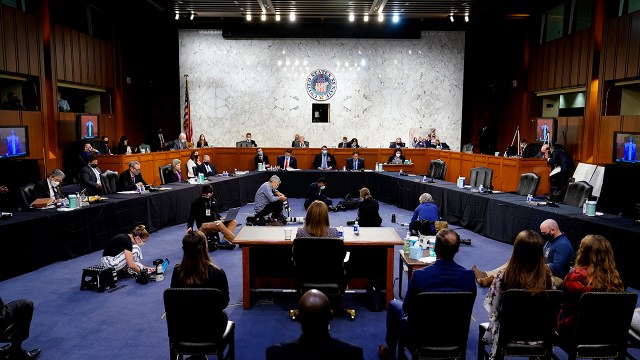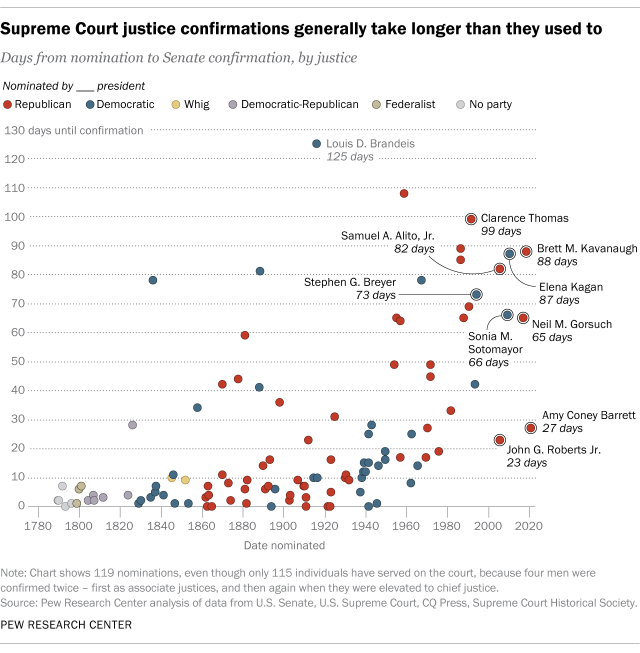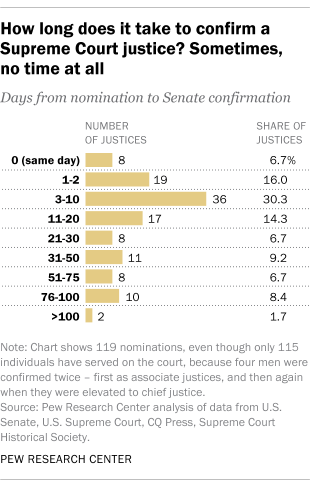
As Democrats and Republicans gear up for what seems an inevitable fight over President Joe Biden’s forthcoming pick to replace retiring Supreme Court Justice Stephen Breyer, it’s worth remembering that vacancies on the high court didn’t always devolve into partisan slugfests.
Consider, for example, the case of Edward Douglass White, who may have had the easiest ride in the court’s 233-year history. On Feb. 19, 1894, President Grover Cleveland nominated White, then a senator from Louisiana, as an associate justice after the Senate had rejected his first two picks. The Senate confirmed White later that day on a voice vote (“All those in favor say ‘Aye!’”). Sixteen years later, on Dec. 12, 1910, President William Howard Taft tapped White to be the new chief justice; again he was confirmed that same day, and again on a voice vote. (“All opposed say ‘Nay.’ The Ayes appear to have it!”) All told, White served on the court for more than 27 years, with nary a peep of opposition.
After Justice Stephen Breyer announced that he would retire at the end of the Supreme Court’s current term, we decided to extend some of our previous work on the history of nominations to the high court, this time focusing on how long it took to get nominees confirmed and how close the votes were.
The primary source for this Pew Research Center analysis was the U.S. Senate’s webpage on Supreme Court nominations. We also consulted CQ Press, the Supreme Court Historical Society, and the court itself to supplement and cross-check the information on the Senate page.
When calculating the time between nomination and confirmation, we opted to follow the Senate’s practice of dating nominations from the date of the president’s official nominating letter to the Senate, and confirmations from the date of the final Senate vote on the nominations.
In several cases, a president named someone to the court temporarily via a recess appointment, and subsequently formally nominated them for a permanent position. The only such appointee to not be confirmed was former Justice John Rutledge, who had been off the court for a few years when President George Washington appointed him chief justice. Rutledge began serving in that role in July 1795, but resigned after the Senate rejected his nomination for the permanent job that December.
While 115 individuals have served on the court, our charts show 119 confirmations. That’s because four men were confirmed twice – first as associate justices, and then again when they were elevated to chief justice.
From 1789 to 1941, six other justices besides White were confirmed on the same day they were formally nominated. In fact, of the 115 people who’ve served on the court throughout its history, more than half (61) were confirmed within 10 days of their nominations. The most recent of those, Byron R. White, joined the court nearly 60 years ago, following an undramatic eight-day confirmation process that ended in – you guessed it – a voice vote. (In case you were wondering, he wasn’t related to the previously mentioned Chief Justice White.)
For most of the court’s 233-year history, confirmation processes like those – fast and uncontroversial – were more the norm than the exception. In fact, it wasn’t until the 1916 appointment of Louis D. Brandeis that the Senate Judiciary Committee even held public hearings on a nominee, allowing witnesses to argue for and against Brandeis’ confirmation. At the time, the widespread public attention Brandeis’ nomination attracted and the bitter battles over it made it an exception to the generally placid process of replacing Supreme Court justices, though in hindsight it looks more like an early version of controversies to come.
Brandeis, the first Jewish justice, was controversial because of his legal activism in support of workers’ rights and social reform movements, and in opposition to banks, railroads, insurers and big business generally. After 125 days – still the record for a confirmation battle – Brandeis was confirmed on a 47-22 vote.
But as noted, Brandeis’ confirmation was an exception. From the birth of the republic up to the early 1950s, the average span between nomination and confirmation was 13.2 days. But from Earl Warren in 1954 to Amy Coney Barrett in 2020, the time from nomination to confirmation has averaged 54.4 days.

In the end, though, Warren still was confirmed on a voice vote (after 49 days). The modern era of contentious Supreme Court confirmations really dates to the late 1960s. Between 1789 and 1965, presidents made 130 nominations to the court, including some men (and they were all men at this point) who were nominated multiple times and a few cases of associate justices nominated to be chief justice.
Of those, 68 were confirmed on voice votes and served on the court, and 27 others were confirmed by comfortable margins. Only three justices were confirmed with a margin of fewer than 10 votes. (Another eight nominees were confirmed but never served on the court: Seven declined their appointments, and one died before he could take office.) The Senate rejected nine nominations, and 15 others either failed due to Senate inaction or were withdrawn, for an overall failure rate of 18.5%. (One man, Reuben Walworth, was nominated three separate times in 1844, but the Senate never acted on him.)
Since 1965, there have been 28 Supreme Court nominations, a quarter of which (seven) have failed. Three nominees (Clement Haynesworth, G. Harrold Carswell and Robert Bork) were rejected by the Senate, three others had their nominations withdrawn due to Senate opposition, and the Senate refused to act on one (Merrick Garland).
Of the 21 successful nominees, four were confirmed by a margin of fewer than 10 votes; the other 17 were confirmed by more comfortable margins.




